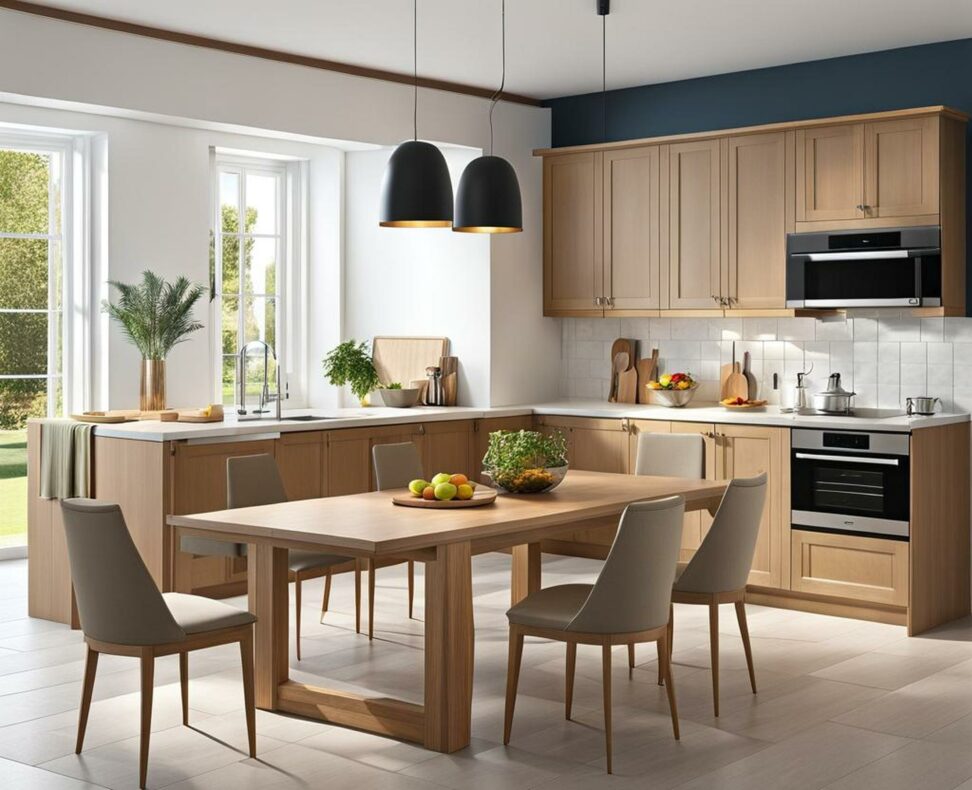Get the Perfect Kitchen Table Size
Finding the ideal kitchen table dimensions can be tricky. The size you choose impacts both aesthetics and functionality. An oversized table crowds the space; a tiny one leaves little room for dining. By considering key factors from seating capacity to design, you can select perfect proportions tailored to your needs.
When measuring for a new kitchen table, start by carefully evaluating the room's current layout and dimensions. Note all permanent existing features that can't be changed, like the position of windows and doors.

Measure Available Space
First, gauge overall length, width and height. Don't forget to account for high-traffic zones where people move frequently. You'll need ample routes for walking between countertops, sinks and appliances without bumping into furnishings.
Leave Sufficient Clearances
Be sure to map any cabinets, shelving or furniture bordering the table area. Leave enough clearance so chairs don't collide when pulled out from the table. Generally a minimum of 36 inches allows comfortable passage while seated. But if the table is flush against a wall, deeper counter depth may suffice.
Consider Built-In Features
If your heart is set on a workspace-dining combo, you may enjoy a table with built-in storage. But integrated drawers and cubbies add both visual and physical bulk. Make sure to compensate for their footprint when calipers are in hand. An extendable table offers flexibility for occasional large gatherings while condensing to save room day-to-day.
Consider Number of Regular Users
Besides measuring the physical room itself, evaluate how many people will regularly dine or work here. Don't merely tally current family members. If your brood is likely to expand soon, scope options accommodating more chairs. Although you can squeeze additional leaves into some tables, capacity can get uncomfortable. And while we adore dinner guests, we don't want knees knocking under the table either!
Choose Table Shape
The shape you pick directly impacts the number of place settings possible. Rectangular tables typically allow more chairs for their footprint. Circular top designs occupy similar square footage as rectangles, yet seat fewer due to curved corners. But round tables foster conversation since everyone faces each other without craning necks. Ovals hit middle ground - slightly more seating than circles but less elbow room.
Define Primary Table Function
Determine the table's main purpose. In smaller kitchens doing double duty for meals and tasks, priority goes to dimensions working best across uses. If dining takes center stage, focus first on comfortable legroom when seated. Position chairs to visualize tabletop needed. If preparing food or doing projects holds equal importance, leave ample surface area for these activities without feeling cramped.
Determine Ideal Table Height
Standard table heights for dining fall between 29" to 31". Bar-style models measuring 36" make small spaces appear larger through contrast. But tall tables aren't best suited for expansive meals. And while low coffee table iterations create intimate ambiance for casual nibbling, they aren't ideal primary dining surfaces. Assess both comfort and your goals when deciding.
Consider Table Material and Construction
The finishes and structure of your table also influence suitable dimensions. Materials like stone and solid wood have innate density and weight working for these substances. Don't select petite sizes unless you adore heavy objects hovering closely during dinner! But lighter metals and glass lend adaptability for smaller spots. Just ensure transparency and gleam align with your overall kitchen aesthetic vision first.
Calculate Appropriate Length and Width
Circling back to step one's measurements, apply those room numbers plus user considerations towards identifying tabletop area. Allow roughly 24" width per seated diner at minimum. Then tailor length based on your shape, keeping at least 36" clearance for opened chairs. An extra cushion is nice for pulling back and standing also. Jot down a few dimension options and visualize each before committing.
The last step merges form and function by blending your preferred size with current kitchen decor. The finish, style and visual weight should feel cohesive within the existing backdrop. So if your schemes lean modern and airy, slender sculptural tables sync better than chunky blocky counterparts. Or if traditional rich cabinetry sets the tone, carved wood tables harmonize beautifully. Balance beauty with practicality for a tailored fit.
Finding that sweet spot balancing aesthetics, seating, workflow and proportions takes some diligence upfront. But once discovered, your perfect kitchen table becomes the heart of the home for years on end. Use these tips when measuring your space to select that "just right" fit feeling like it was always meant to be there.